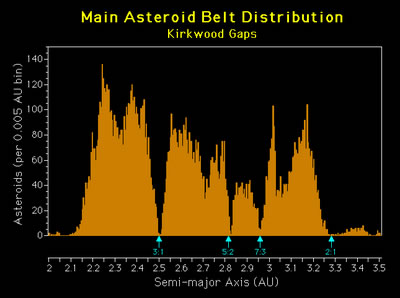Kirkwood Gaps
The distribution of asteroids in the main asteroid belt is not uniform. In particular, there are regions which contain very few asteroids – these are known as the ‘Kirkwood Gaps’.
The result of orbital resonances with Jupiter, these gaps have been cleared of asteroids by the planet’s dominant gravitational influence. For an example of the way it works: an asteroid with a semi-major axis of 3.28 AU will complete two orbits of the Sun for every one of Jupiter (it lies in the 2:1 orbital resonance). Once every two orbits, the relative positions between the asteroid and Jupiter will be the same, and the repeated tugs from Jupiter at this point will change the orbital elements of the asteroid. This can create a gap (which is the case here) or a concentration of asteroids at that distance.
All asteroids with orbital distances that form a simple ratio with that of Jupiter will be affected by such gravitational perturbations. Key Kirkwood gaps occur at the 2:1, 3:1, 5:2, and 7:3 orbital resonances, while major concentrations of asteroids are found at the 3:2 and 1:1 (Trojan asteroids) orbital resonances.
Study Astronomy Online at Swinburne University
All material is © Swinburne University of Technology except where indicated.


